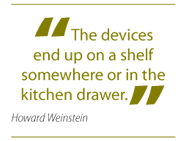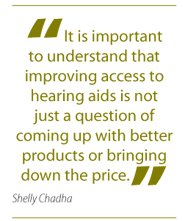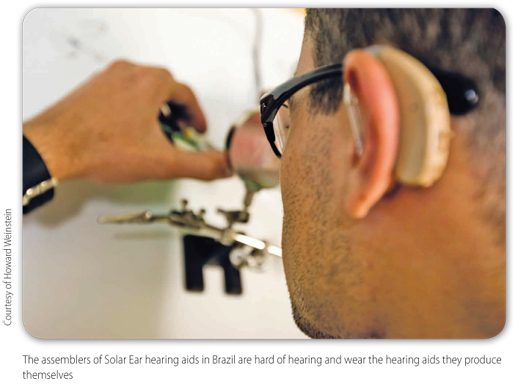NEWS
Technology transfer aids hearing
India is one of a growing number of countries looking at technology transfer to improve access to reliable, low-cost, digital hearing devices. Gary Humphreys reports.
"There are four types of hearing aids sold in developing countries," jokes Howard Weinstein, the Canadian creator of the Solar Ear, a low-cost digital hearing aid. "There's the BTE, the ITE, the ITC and the ITD. "
For hearing aid users the first three acronyms will be familiar (the initials stand for 'behind the ear', 'in the ear' and 'in the canal' models) but, according to Weinstein, it is the last model that people in developing countries often end up owning the 'in the drawer' model.
"In the developing world people lucky enough to own a hearing aid either can't get hold of or can't afford the batteries which, by the way, they have to replace once a week," Weinstein explains. "So the devices end up on a shelf somewhere or in the kitchen drawer. "
It was partly to get hearing aids out of the kitchen drawer that Weinstein, with the help of electronics engineers and in consultation with hearing-impaired youngsters at a school for the deaf in the village of Ramotswa, Botswana, developed the Solar Ear back in 2003.
Weinstein believes that it is the world's first hearing aid with a solar-powered charger that can also be plugged into a light socket to recharge.
The high cost of regularly replacing hearing aid batteries is just one of the reasons hearing-impaired people in low- and middle-income countries have to get by without hearing aids; another is the cost of the devices themselves.
According to a survey published in Consumer Reports magazine in 2009, consumers in the New York metropolitan area spend between US$ 1800 and US$ 6800 on a hearing aid. A similar situation prevails in Europe, where, according to Dr Shelly Chadha, a technical officer in WHO's Department of Prevention of Blindness and Deafness, high-end digital hearing aids can cost as much as US$ 10 000.

"Prices are lower in low- and middle-income countries but still prohibitively high, making hearing aids an unaffordable luxury for the vast majority of people," Chadha says.
Roughly 360 million people live with disabling hearing loss globally, the majority of them in low- and middle-income countries where fewer than 3% of people who need a hearing aid actually have one.

According to Chadha, one of the key reasons for the failure to meet demand is the cost of the devices available, and the reason they are so expensive is the dominance of five producers. However, Chadha is keen to point out that the lack of access to hearing devices in low- and middle-income countries is also due to a shortage of trained personnel to fit the devices and provide maintenance and repair services for these hearing aids, as well as unreliable battery supplies.
Ironically, the leading hearing aid companies typically source their components in low- and middle-income countries, including Brazil, China, Colombia, India and South Africa, where these devices are often assembled as well, and, according to Weinstein, they pay tens rather than thousands of dollars per assembled unit.
For Dr Francis Moussy, who heads WHO projects facilitating the development and use of medical devices for ageing populations, the disparity between production cost and retail price for what is after all an essential medical device, makes hearing aids prime candidates for technology transfer.
Stated simply, technology transfer involves the sharing of product specifications and manufacturing know-how with a producer in a country where the need for the product is not being met.
While technology transfer takes a variety of forms, ranging from straightforward licensing agreements to the actual transfer of know-how and equipment, a key reason why countries use it is to improve access to the medical devices and drugs their populations need, but cannot afford.
However, as Moussy points out, making products more accessible is not the only benefit of technology transfer. It also presents opportunities to meet local need for certain products, and this can be done by establishing what is known in the technology transfer world as the "target product profile" or TPP.
Establishing a TPP is the one of the first steps taken by Moussy and his team in facilitating technology transfer.
"We talk to end users and take into account local conditions, which allows us to draw up the target product profile, and then we approach manufacturers to see if they are already making something that approximates the profile or to see if they are interested in adapting an existing product or making something new," Moussy says.
"With companies that have suitable products, we discuss technology transfer options to bring down the price of the devices," Moussy says, adding: "Whenever possible and appropriate, we also try to promote technology transfer coupled with local production of the products to increase production capacity in countries where that is lacking. "
It was with this aim in mind to establish a target product profile for hearing aids that WHO organized an ad hoc consultation at WHO headquarters in March, inviting a wide range of scientific and technical experts as well as representatives from industry and nongovernmental organizations.
Among the recommendations to come out of the consultation apart from a target US$ 4060 price range for digital hearing devices was for further consultation on ear mould technology that would be suitable for use in poor countries, and rechargeable battery options, including solar-powered chargers.
Howard Weinstein, one of the industry representatives attending the ad hoc consultation, gave a seven-minute presentation of his work on the Solar Ear which is "open fit" and does not require an ear mould.
A self-styled social entrepreneur, Weinstein is a fervent believer in technology transfer and has been committed to sharing his product from the beginning, not least so that children in low- and middle-income countries with hearing loss can benefit from it.

"We could have patented the Solar Ear charger in a heartbeat, but we wanted people to copy us. In fact if somebody ends up producing a cheaper, better version of the Solar Ear and uses their distribution channel to get more products to more children with hearing loss, we will have attained our objective even if that puts us out of business," he says.
Until recently Brazil was the only country to have taken advantage of the Solar Ear technology that was developed in Botswana, but this year, according to Weinstein, the Solar Ear will go into production in China, Mexico, the Russian Federation and Singapore, all using the technical specifications and detail of the manufacturing processes provided free of charge by Weinstein. His only condition: that deaf people be involved in the product's manufacture.

In May, Weinstein concluded a memorandum of understanding with the Artificial Limbs Manufacturing Corporation of India (ALIMCO), a state-owned company, whose Chairman and Managing Director Shri G Narayan Rao, saw Weinstein's presentation at the ad hoc consultation in March.
Rao believes that ALIMCO already produces the world's most cost-effective hearing aid, but he is particularly interested in the Solar Ear's solar-powered charger. In April, the company put in an order for 50 Solar Ear charging units. It plans to give the devices to users and to get their feedback.
"If the solar charger turns out to be cost-effective, we will request a transfer of technology from Solar Ear," Rao says. If all goes well, ALIMCO will start production with an expected output of between 100 000 and 150 000 units next year, representing roughly 40% to 50% of India's annual hearing aid production, Rao says.
"We will be watching developments at ALIMCO with considerable interest," says WHO's Chadha, who believes that ALIMCO's manufacturing muscle could make a significant dent in the unmet need for hearing aids not just in India, but across the globe. However, Chadha also sounds a note of caution.
"It is important to understand that improving access to hearing aids is not just a question of coming up with better products or bringing down the price," she says.
"It is also vital to consider the provision of the services required for fitting hearing devices, including the provision of ear moulds, as well as the maintenance of these devices. To overcome these challenges, countries will have to address broad health system issues, including, notably, the lack of skilled health workers that are needed to fit and maintain these hearing aids. " 
